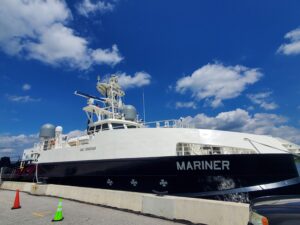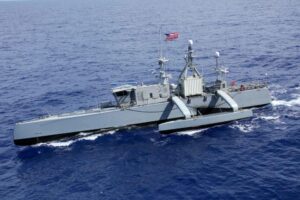Experiments with Medium Unmanned Surface Vessels (MUSVs) have helped push the Navy to more securely see the value in the vessels as “advantageous” going forward, a service officer said last week
While the Navy has been confident in using Large USVs as an “adjunct magazine capacity,” Rear Adm. Fred Pyle, director of the surface warfare division at OPNAV N96, confirmed the MUSVs will be used more for intelligence, surveillance, reconnaissance and targeting purposes.

“We’re committed to that effort and the opportunities that medium unmanned vessels bring to employ C5ISR&T assets,” Pyle said during a Jan. 11 panel discussion at the Surface Navy Association’s annual symposium.
C5ISR&T translates to Command, Control, Computers, Communications, Cyber, Intelligence, Surveillance, Reconnaissance and Targeting.
As recently as April, Chief of Naval Operations Adm. Michael Gilday said he thinks the Navy would be in a better place with Large USVs by 2030 but was unsure if there would be a place for MUSVs (Defense Daily, April 28, 2022).
Speaking to reporters following the panel, Pyle confirmed the Navy will have seven MUSV prototypes in the inventory by the end of the year.
These include the Sea Hunter and Sea Hawk MUSVs, four total planned Overlord large USVs, and a medium USV prototype contracted to L3Harris Technologies [LHX].
He said Surface Development Squadron and USV Division One operations with the completed vessels have helped develop a good command and control structure.
“We’re doing a lot of storming and norming in the space of what the C2 looks like, how we do the operational employment, and what the future of the medium unmanned platform is,” Pyle said.
He added that the Navy’s work thus far on MUSVs, focusing on C5ISR&T capability, “is proving to be advantageous.”
Pyle underscored “we’ve learned a lot from recent events such as RIMPAC. And we’re going to continue to take opportunities or exercises in fleet experimentation to determine what’s the best capability to get on there to support distributed maritime operations.”

During RIMPAC, the Navy paired the Sea Hunter and Seahawk each with a separate destroyer while the Nomad and Ranger Overlord USVs were controlled from the Navy’s Unmanned Operations Center (UOC) at Naval Base San Diego (Defense Daily, Aug. 8).
While he admitting nothing is absolutely firm, Pyle said “we are very excited about the prospects of what MUSV can bring, and we have investments to continue to work with those seven prototypes, and they bring a lot of capability.”
Pyle also noted the Navy is invested in the MUSV and is more definitively moving out on it.
“The [Program Executive Office for Unmanned and Small Combatants] and I are lockstep. And we’ve got very good dialogue with the fleet on what we want to accomplish with this platform,” he added.